
Author Archive
-

We participated at the 7th European Cyclodextrin Conference in Budapest, Hungary on 5-8th September 2023
We participated at the 7th European Cyclodextrin Conference in Budapest, Hungary on 5-8th September 2023.
The event continues the traditions of the conference series (2009 Aalborg, Denmark; 2011 Asti, Italy; 2013 Antalya, Turkey; 2015 Lille, France; 2017 Lisbon, Portugal; 2019 Santiago de Compostela, Spain) with a special focus on young researchers and students.
The aim of the conference series is to provide an European platform for the enhancement of scientific knowledge on cyclodextrins and to promote the exploitation of their unique properties in various applications.
Our group was represented by Dr. Mónika Molnár, Zsófia Berkl and Rita Márton who presented the results of our scientific work in the poster session.
- MODULATION OF BACTERIAL COMMUNICATION BY CYCLODEXTRINS – CURRENT RESEARCH TRENDS AND FUTURE PERSPECTIVES (A bakteriális kommunikáció befolyásolása ciklodextrinekkel – aktuális kutatási trendek és jövőbeli perspektívák)
Mónika Molnár, Rita Márton, Ildikó Fekete-Kertész, Imre Németh, Lajos Szente, Éva Fenyvesi, Zsófia Berkl
2. α-CYCLODEXTRIN FROM AN ECOTOXICOLOGICAL POINT OF VIEW – EXAMINATION OF THE POTENTIAL TOXICITY WITH A COMPLEX METHODOLOGY (Az α-ciklodextrin ökotoxicitása – a potenciális toxicitás vizsgálata egy komplex metodológiával)
Zsófia Berkl , Ildikó Fekete-Kertész, Klaudia Benei, Éva Fenyvesi, Lajos Szente, Mónika Molnár
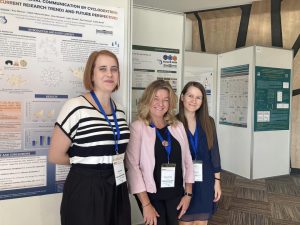
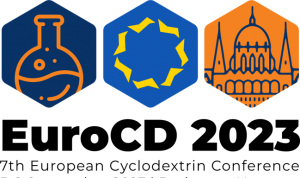
- MODULATION OF BACTERIAL COMMUNICATION BY CYCLODEXTRINS – CURRENT RESEARCH TRENDS AND FUTURE PERSPECTIVES (A bakteriális kommunikáció befolyásolása ciklodextrinekkel – aktuális kutatási trendek és jövőbeli perspektívák)
-

Dr. Viktoria Feigl has been officially appointed Associate Professor
Congratulations to our colleague, Dr. Feigl, Viktoria who has been officially awarded the Associate Professor title as of the 1st of April 2023!
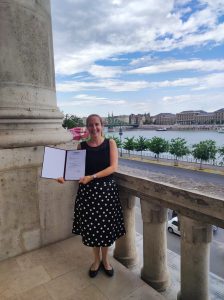
-

Our colleagues amongst the TOP 100 best educators of BME
Based on the Student Opinion Survey (OHV) for the autumn semester of the academic year 2022/23, two members of our group (Márton Rita and Berkl Zsófia) were voted by the students among the best 100 lecturers at BME.
Congratulations on the achievement!

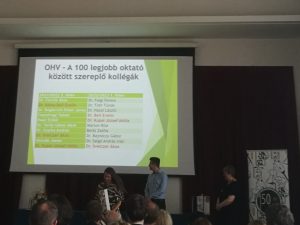
-

Dr. Viktória Feigl introduced our group at the BME FIEK Innovation day
As last year, this year, we participated again at the BME FIEK Innovation day on the 09th of June 2023.
We were represented by Dr. Feigl Viktória who introduced our group, the research activity and the topics and areas within which we are looking for partners for the calls announced in the HORIZON programme.
The video recording can be reached at https://www.facebook.com/BMEFIEK/videos/801084091654974 and the presentation in the attachment.
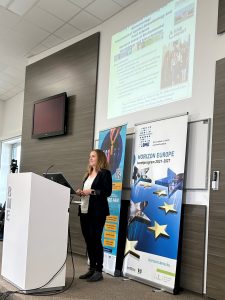
-

We participated again at the Spring Wind Conference and we won two 1st prizes
The Association of Hungarian PhD and DLA Candidates (DOSZ) in collaboration with the University of Miskolc, Hungary have organised again the multidisciplinary scientific conference labelled as the Spring Wind Conference in Miskolc, between 5-7th of May 2023.
Young researchers and doctoral candidates from all scientific disciplines had the opportunity to present their research outcomes in Hungarian and English, both in oral or poster sessions.
Our PhD students participated in two subsections and were awarded the 1st prize.
Rita Márton, (PhD supervisor: Dr. Mónika Molnár) was awarded the 1st prize in the Microbiology and Biotechnology subsection for the following oral presentation:
- Márton Rita, Margl Márk, Szabó Eszter, Dr. Molnár Mónika – Assessment of the effect of cyclodextrines in the Candida albicans and Candida boidinii test systems
Szabina Molnár, (PhD supervisor: Dr. Mónika Molnár) was awarded the 1st prize in the Environmental science subsection for the oral presentation of the following topic:
- Molnár Szabina, Dr. Molnár Mónika, Mátyus Nikolett, Novák Lilla – Aging induced alterations in biochar properties and in their effects on soils
Congratulations and further successes in your scientific career!
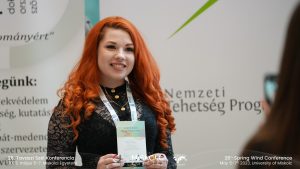
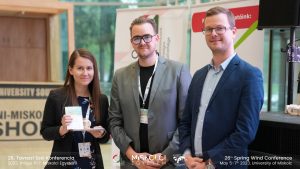
-
Zsófia Berkl has successfully applied for the Pungor Ernő pre-PhD degree award scholarship
 Our PhD student, Zsófia Berkl (supervisor: Dr. Mónika Molnár) has successfully applied for the Pungor Ernő pre-PhD degree award scholarship granted by the Oláh György Doctoral School of BME, Faculty of Chemical Technology and Biotechnology.
Our PhD student, Zsófia Berkl (supervisor: Dr. Mónika Molnár) has successfully applied for the Pungor Ernő pre-PhD degree award scholarship granted by the Oláh György Doctoral School of BME, Faculty of Chemical Technology and Biotechnology.The call was announced for PhD students completing with outstanding success all classes required for the PhD degree (absolutorium) and who have not yet obtained their PhD degree.
Congratulations Zsófi for your successful application!
-
Scientific articles published by our research group during 2021-2023
The scientific publications of our research group in cooperation with national and/or international scientists during 2021-2023 in various scientific journals include the following:
- Fekete-Kertesz, I., Stirling, T., Vaszita, E., Berkl, Zs., Farkas, É., Hedwig, S., Remmen, K., Lenz, M., Molnar, M., Feigl, V. (2023) Ecotoxicity attenuation by acid-resistant nanofiltration in scandium recovery from TiO2 production waste, Heliyon 9, e15512, https://doi.org/10.1016/j.heliyon.2023.e15512
- Fenyvesi, É., Berkl, Zs., Ligethy, L., Fekete-Kertész, I., Csizmazia, M., Malanga, M., Puskás, I., Szőcs, L., Varga, E., Szente, L., Molnár, M. (2023) Novel Alkyl Thioether Cyclodextrin Derivatives Against Bacterial Quorum Sensing in Aliivibrio fischeri, Beilstein Journal Of Organic Chemistry pp. 1-41. , 41 p.
- Favier, L., Simion, A.I., Hlihor, R.M., Fekete-Kertész, I., Molnár, M., Harja, M., Vial, C. (2023) Intensification of the photodegradation efficiency of an emergent water pollutant through process conditions optimization by means of response surface methodology. Journal of Environmental Management, 328, Paper: 116928. DOI:doi.org/10.1016/j.jenvman.2022.116928.
- Dell’Armi, E., Zeppilli, M., Di Franca, M. L., Matturro, B., Feigl, V., Molnár, M., Berkl, Zs., Németh, I., Yaqoubi, H., Rossetti, S., Papini, M. P., Majone, M. (2022) Evaluation of a bioelectrochemical reductive/oxidative sequential process for chlorinated aliphatic hydrocarbons (CAHs) removal from a real contaminated groundwater, Journal of Water Process Engineering, 49, 103101, https://doi.org/10.1016/j.jwpe.2022.103101
- Cruz Viggi, C., Tucci, M., Resitano, M., Matturro, B., Crognale, S., Feigl, V., Molnár, M., Rossetti, S., Aulenta, F. (2022) Passive electrobioremediation approaches for enhancing hydrocarbons biodegradation in contaminated soils, Science of The Total Environment, 845, 157325, ISSN 0048-9697. https://doi.org/10.1016/j.scitotenv.2022.157325.
- Berkl, Z.; Fekete-Kertész, I.; Buda, K.; Vaszita, E.; Fenyvesi, É.; Szente, L.; Molnár, M. (2022) Effect of Cyclodextrins on the Biofilm Formation Capacity of Pseudomonas aeruginosa PAO1. Molecules, 27, 3603. https://doi.org/10.3390/ molecules27113603
- Kerekes, I. K., Pusztai, Éva, Feigl, V., Kemény, S. (2022) Acute Ecotoxicological Effects of Bauxite Residue Addition on Mortality and Motion-frequency of Dendrobaena veneta and Enchytraeus albidus (Annelida) in Three Types of Soils, Periodica Polytechnica Chemical Engineering, 66(3), 512–524. https://doi.org/10.3311/PPch.19868
- Németh, I., Molnár, S., Vaszita, E., Molnár, M. (2021) The Biolog EcoPlate™ Technique for Assessing the Effect of Metal Oxide Nanoparticles on Freshwater Microbial Communities, Nanomaterials , 11(7), 1777. https://doi.org/10.3390/nano11071777
- Farkas, E., Feigl, V., Vaszita, E., Uzinger, N., Rékási, M., Gruiz, K., Molnár, M. (2021) Screening and Ranking Methodology Applied to Biochars Aimed at Acidic and Calcareous Sandy Soil Improvement, Periodica Polytechnica Chemical Engineering, 65(3), 361-377. https://doi.org/10.3311/PPch.17163
- Hirsch, E., Pantea, E., Vass, P., Domján, J., Molnár, M., Suhajda, Á., Andersen, S. K., Vigh, T., Verreck, G., Marosi, Gy. J. et al. (2021) Probiotic bacteria stabilized in orally dissolving nanofibers prepared by high-speed electrospinning, Food and Bioproducts Processing, 128, 84-94, 11 p. https://doi.org/10.1016/j.fbp.2021.04.016
- Molnár, M., Fenyvesi, E., Berkl, Zs., Németh, I., Fekete-Kertész , I., Márton, R., Vaszita, E., Varga., E. , Ujj, D., Szente, L. (2021) Cyclodextrin-mediated quorum quenching in the Aliivibrio fischeri bioluminescence model system – Modulation of bacterial communication, International Journal of Pharmaceutics, 594, 120150. https://doi.org/10.1016/j.ijpharm.2020.120150
-
Successfully completed complex exam in January 2023
 Congratulations to our PhD students, Rita Márton (PhD research topic: Modulation of Quorum Sensing (QS) in fungi, Supervisor: Dr. Mónika Molnár) and Szabina Molnár (PhD research topic: The effect of biochar ageing on biochar properties and on its applicability in soil, Supervisor: Dr. Mónika Molnár) for the successful complex exam in January 2023.
Congratulations to our PhD students, Rita Márton (PhD research topic: Modulation of Quorum Sensing (QS) in fungi, Supervisor: Dr. Mónika Molnár) and Szabina Molnár (PhD research topic: The effect of biochar ageing on biochar properties and on its applicability in soil, Supervisor: Dr. Mónika Molnár) for the successful complex exam in January 2023.The complex exam or comprehensive exam is an oral exam due at the end of the 4th semester of PhD studies. Its goal is to determine how well-prepared PhD candidates are for the next step of their academic career, in order to write their dissertation.
-
We participated at the 4th George Oláh Conference held at BME
 Dr. Feigl Viktória represented our group at the 4th George Olah conference organised at Budapest University of Technology and Economics, Faculty of Chemical Technology and Biotechnology on the 26th September 2022, where she held an oral presentation about the re-use of bauxite residue primarily based on the research results of our group during the last 15 years.
Dr. Feigl Viktória represented our group at the 4th George Olah conference organised at Budapest University of Technology and Economics, Faculty of Chemical Technology and Biotechnology on the 26th September 2022, where she held an oral presentation about the re-use of bauxite residue primarily based on the research results of our group during the last 15 years.The oral session was online streamed: https://www.youtube.com/watch?v=RDr6bcmEUTg
The conference programme and the abstract of presentations can be reached at the following website: https://docplayer.net/230332294-4-th-george-olah-conference.html.
-
We participated at the ISMET8 Conference in Chania, Crete on 19-23 September, 2022
 Dr. Feigl Viktoria participated on behalf of our group at the ISMET8 -International Society for Microbial Electrochemistry and Technology – GLOBAL CONFERENCE in Chania, Crete on 19-23 September, 2022, organised by the Technical University of Crete, the University of Ghent and the University of Alcalá.
Dr. Feigl Viktoria participated on behalf of our group at the ISMET8 -International Society for Microbial Electrochemistry and Technology – GLOBAL CONFERENCE in Chania, Crete on 19-23 September, 2022, organised by the Technical University of Crete, the University of Ghent and the University of Alcalá.The following poster (ID 222_Conference programme page 25 ) was presented on behalf of the group:
Mónika Molnár, Zsófia Berkl, Éva Farkas, Ildikó Fekete-Kertész, Rita Márton, Imre Németh, Szabina Molnár, Emese Vaszita, Viktória Feigl:
Ecotoxicity test batteries for the monitoring of bio-electrochemical system based remediation technologies
The abstract of the poster presentation can be reached in the e-book of abstracts at: ISMET8 eBook-of-Abstracts.pdf


